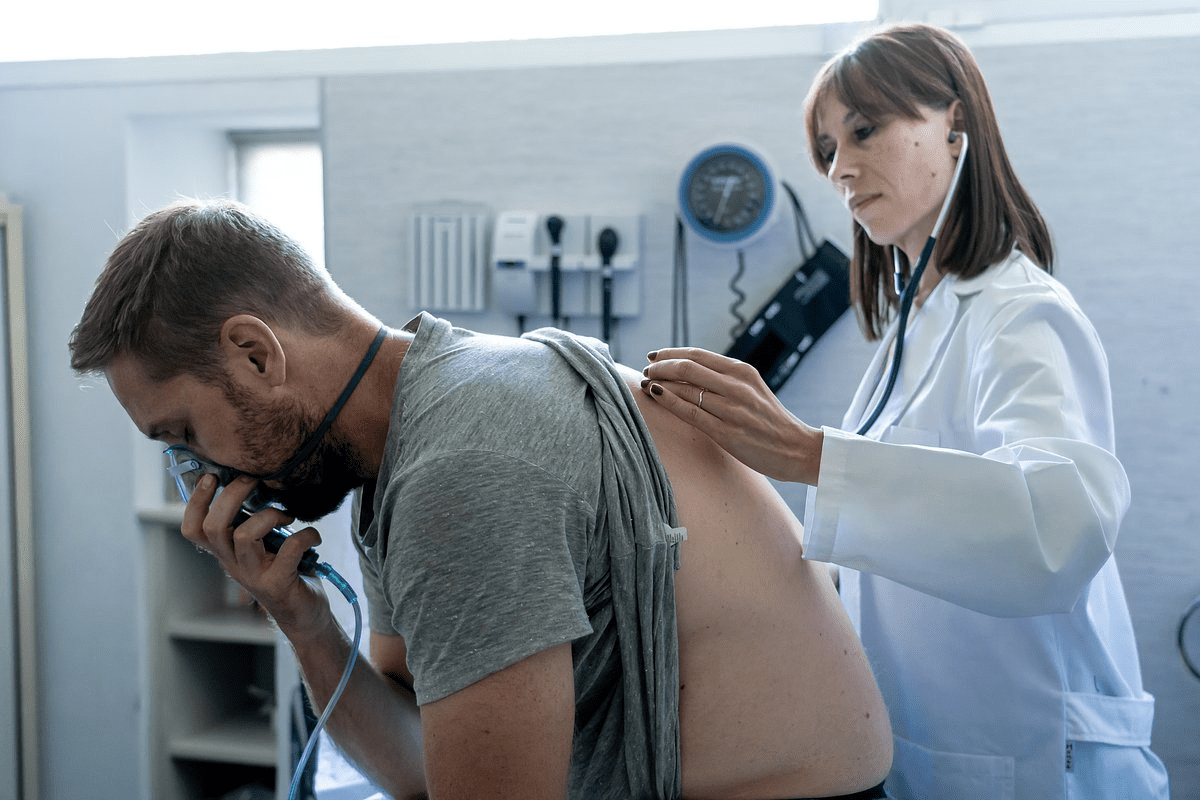Last Updated on November 25, 2025 by Ugurkan Demir

If you have invasive bladder cancer, a big surgery might be needed. Cystectomy, or removing the bladder, is a major operation. It can change your life but also offers a chance to get better.
Get a comprehensive understanding of urinary bladder removal (cystectomy), including the reasons for the procedure and post-surgery life.
Cystectomy is chosen when other treatments don’t work. It means taking out the bladder. This surgery is complex and needs a lot of thought and planning.

Cystectomy is a surgery that removes part or all of the bladder. It’s used to treat different bladder problems, like cancer.
There are two main types: partial and radical cystectomy. Partial cystectomy removes only the diseased part of the bladder. This keeps more of the bladder intact. It’s used when the disease is in one area.
Radical cystectomy removes the whole bladder and sometimes nearby tissues. It’s used for more widespread disease.
The history of cystectomy as a treatment has grown a lot. New surgical methods and care after surgery have made it better. Now, it’s seen as a good option for bladder issues.
Bladder cancer is a serious condition that may require the removal of the bladder, known as cystectomy. This is often the case when the cancer is invasive. Understanding the indications and the procedure can help patients and their families navigate this challenging diagnosis.
Invasive bladder cancer is a significant health issue that necessitates prompt and effective treatment. The decision to remove the bladder is made when the cancer has grown beyond the inner lining into the muscle layer. This poses a higher risk of spread to other parts of the body.
Bladder removal surgery, or cystectomy, is a major operation. It involves removing the bladder and sometimes surrounding tissues and organs. This procedure is often considered when other treatments are not effective or feasible.
Patients undergoing bladder removal surgery should be aware of the risks and complications. They should also understand the recovery process. With proper care and support, individuals can adapt to life after bladder removal and manage their condition effectively.
Effective management and treatment of bladder cancer require a complete approach. This includes surgery, possibly followed by other therapies like chemotherapy or radiation therapy. Understanding the disease, its treatment options, and the support available is key for patients and their families.
By providing clear information and support, healthcare professionals can help individuals navigate the challenges of bladder cancer. This improves their quality of life.
Diagnosing bladder cancer starts with looking at your medical history and doing a physical exam. Tests like ultrasound, CT scans, and MRI scans are also used. These help figure out how far the cancer has spread using the TNM staging system.

The journey to bladder removal surgery starts with careful preparation. Before cystectomy, patients must go through medical tests and assessments. This ensures they’re ready for the procedure.
We run various tests to check the patient’s health and bladder condition. These include:
Talking with the surgical team is key before surgery. We review the patient’s medical history, the surgery plan, and recovery expectations. It’s also a chance for patients to ask questions and understand the surgery.
Talking about urinary diversion options is part of the prep. We explain types like ileal conduit, neobladder reconstruction, and continent urinary reservoir. This helps patients make informed choices about their care.
By evaluating the patient’s condition and discussing options, we tailor the surgery. This ensures the best results for each patient.
After a cystectomy, patients have several urinary diversion options. The main types are ileal conduit, neobladder reconstruction, and continent urinary reservoir.
The ileal conduit creates a conduit from intestine to divert urine. It’s simple and used for those not suited for complex procedures.
Neobladder reconstruction makes a new bladder from intestine. It offers natural urination, making it a good choice for some patients.
A continent urinary reservoir stores urine in a pouch. It needs catheterization for drainage. It’s for patients not suited for other options.
Each option has its pros and cons. The right choice depends on the patient’s needs and preferences.
Removing the bladder, or cystectomy, is a detailed surgery. It involves taking out the bladder. There are two main ways to do this: open cystectomy and robotic-assisted laparoscopic cystectomy.
Open cystectomy means making a big cut in the belly to get to the bladder. This old-school method lets surgeons see the bladder and nearby tissues clearly.
Robotic-assisted laparoscopic cystectomy is a new, less invasive way to remove the bladder. It uses a robotic system through small belly cuts. This method lets surgeons see the bladder on a screen.
Both methods have good points and bad points. Open cystectomy is more invasive but lets surgeons see everything. Robotic-assisted cystectomy is less invasive, causing less damage and possibly fewer problems.
After cystectomy, patients need to follow up closely. They should follow their doctor’s advice on pain, wound care, and check-ups.
Bladder removal surgery, or cystectomy, is a big deal. It comes with risks and complications. It’s important for patients to know these risks to make good choices about their health.
Right after surgery, patients might face infections, bleeding, or bad reactions to anesthesia. It’s key to watch them closely after surgery. This way, any problems can be caught and fixed fast.
Later on, patients might deal with issues like kidney damage or urinary tract infections. Knowing these risks helps. Working closely with doctors can help avoid or manage these problems.
To avoid complications, patients should listen to their doctors and keep up with follow-up visits. This is a big part of staying safe and healthy.
After bladder removal surgery, patients start a key recovery phase. The time spent in the hospital varies. But, patients are watched closely for days to help them adjust smoothly.
Managing pain is very important during recovery. Doctors give patients pain medicine to help with discomfort. The kind and amount of medicine depends on the patient’s health.
Because the bladder is gone, a new way to manage urine is needed. This can be a neobladder or an ileal conduit. The choice depends on the patient’s health and the surgeon’s advice.
Recovering from surgery takes time and following doctor’s orders is key. With the right care, patients can heal well and adjust to their new life.
After a cystectomy, patients face big changes in their daily lives. They must learn to manage a new urinary system. They also need to deal with emotional changes and find support.
Patients will have to get used to using an ostomy bag or other urinary methods. It takes time, so patience is key. Seeking support when needed is also important.
The emotional side of a cystectomy is just as important. Patients might feel anxious, depressed, or like they’ve lost something. Talking to others who have gone through the same thing can help a lot.
There are many resources to help adjust to life after a cystectomy. These include support groups, counseling, and online forums.
By being open to change and seeking support, individuals can move forward in their lives.
Survival rates after cystectomy have seen a big jump thanks to better surgery and care after surgery. The five-year survival rate is about 63.2%. Survival depends on the cancer’s stage, the patient’s health, and the quality of care.
Regular check-ups are key to catching problems early. This helps improve long-term results. Knowing these points helps patients manage their recovery better.
Bladder removal surgery is a complex and personal journey. With the right medical team and support, people can successfully go through it. They can also adapt to the changes that come after.
By giving thorough care and education, we help people manage their health. This is true even when facing a big medical challenge.
Bladder removal surgery, also known as cystectomy, is a procedure to remove the bladder. It’s often done to treat bladder cancer or other bladder issues.
It’s needed for treating bladder cancer, severe bladder damage, or other diseases. These conditions affect the bladder’s function.
There are several types, including ileal conduit, neobladder reconstruction, and continent urinary reservoir. Each has its own purpose.
Radical cystectomy removes the bladder, surrounding tissues, and lymph nodes. Partial cystectomy only removes the affected part of the bladder.
Risks include infection, bleeding, and anesthesia complications. Long-term issues might be urinary incontinence, sexual problems, and bowel habit changes.
Recovery time varies. It depends on the surgery’s complexity and the individual. Patients usually stay in the hospital for several days to a week or more.
The survival rate depends on the cancer’s stage and type, and the treatment’s success. Early-stage bladder cancer patients generally have a better prognosis than those with advanced cancer.
Bladder removal surgery can impact life quality. But, many people adapt and live active lives with proper care and management.
After surgery, patients might use a urinary diversion or have a new bladder created. This can change urination patterns or lead to incontinence.
Long-term effects include changes in urinary function and the need for ongoing medical care. Regular check-ups with a healthcare provider are key to managing these effects.
National Center for Biotechnology Information- How to Understand Bladder Removal Surgery Cystectomy If. Retrieved from https://pmc.ncbi.nlm.nih.gov/articles/PMC3966145/
Subscribe to our e-newsletter to stay informed about the latest innovations in the world of health and exclusive offers!